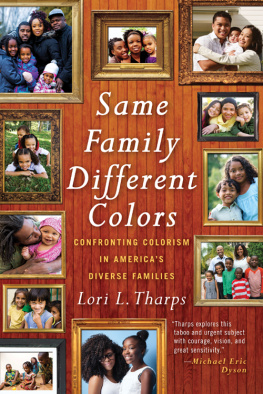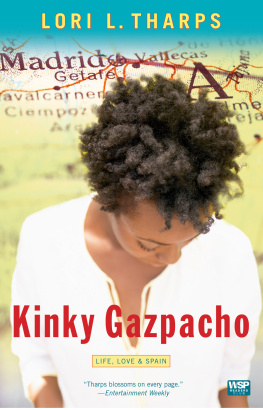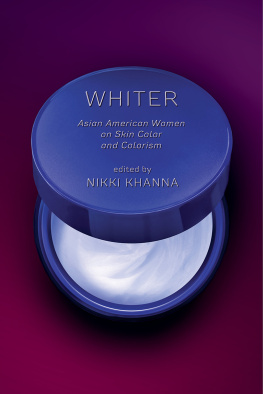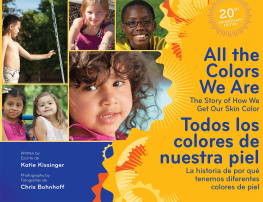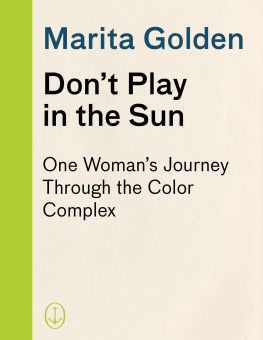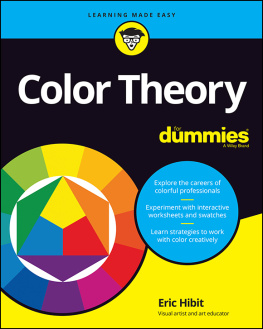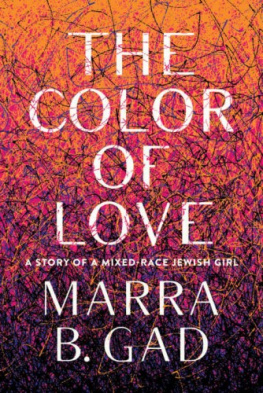
Oh boy... Gods not black. Hes not white. Hes a spirit.
Does he like black or white people better?
He loves all people. Hes a spirit.
Whats a spirit?
A spirits a spirit.
What color is Gods spirit?
It doesnt have a color, she said. God is the color of water.
J AMES M C B RIDE , The Color of Water:
A Black Mans Tribute to His White Mother
For my original rainbow coalition:
Manuel, Esai, Addai, and Aida
AUTHORS NOTE
Talking about color is hard. Admitting you and the people you love have been affected by colorism is even harder. Understandably, some of the people I interviewed for this book did not want their real names used for fear of hurting others, as well as for their own protection. I had no problem honoring their wishes. However, my manuscript started to look quite messy with all of the asterisks and explanations of which names were real and which were actually pseudonyms.
To make it easier on everyone, I have changed all names and identifying details of the people I interviewed for this book, with the exception of the public figures. I define public figures as authors, academics, celebrities, journalists, and activists. In other words, I used the real names of all of the people I interviewed for their expert opinion on colorism and pseudonyms for those who were generous enough to share their stories about living in a home of many colors. In two or three cases these categories overlapped and I chosewith permissionto use real names.
INTRODUCTION
The first difference which strikes us is that of colour.
THOMAS JEFFERSON, Notes on the State of Virginia
I spy something white!
The game was getting good. It was 2012 and I was sitting in the dimly lit hallway of the Settlement Music School in the Germantown section of Philadelphia. To pass the time while waiting for my son to finish his guitar lesson, I was playing I Spy with an adorable five-year-old Black girl whose beaded cornrows were keeping my daughter Aida entertained. The little girls father smiled at me in gratitude for keeping his child occupied while he attempted to read the newspaper. It was a win-win situation for everyone.
So, Im looking for something white, I repeated, scanning the dull-green walls, sandy-brown carpet, and dark wooden benches lining the hallway. I didnt see anything light, bright, or remotely white in the vicinity. Since the girl was only five and on a previous turn had spied an invisible purple horse, I began to guess some imaginary white objects she may have seen.
Is it a snowflake? I asked.
No, she giggled.
Is it a giant marshmallow man?
Uh-uh, she shook her head and her braids made a delightful tinkling sound. Aida reached for them in awe with her pudgy little fingers.
Is it a flying white unicorn with glitter on her wings? I tried.
No! The girl screeched with laughter. Its her, she declared as she pointed directly at my daughter with a challenge in her eye and an accusation in her tone. Shes white!
I opened my mouth to respond, but no words came out. A five-year-old had rendered me speechless. Before I could figure out how to, or even if I should, correct the little girls erroneous assumption, her father yanked her to her feet, mumbled an embarrassed apology to me, and dragged the girl toward the downstairs waiting area. I could hear her protests as he ushered her to the steps, But she is white, Daddy. She is!
Aida climbed up on the bench next to me and started playing with my hair instead. My dreadlocks didnt have any fancy beads, but they could still be pulled and tugged for entertainment. I hauled my child on to my lap and took a good look. Indeed, even in the windowless light of the music school, my sixteen-month-old daughter looked like a little white girl. Her round, cherubic face was all strawberries and cream, and her jet-black hair hung straight to her shoulders with just the hint of a wave at the ends. I sighed. Children dont lie. That little girl had only said aloud what most people probably thought when they saw my daughter anyway. Shes white. But Im Black. So, how did that happen?
From a biological perspective its an easy question to answer. There are more than one hundred different genes that influence skin pigmentation. Scientists havent even begun to isolate all of them yet. The variations of human skin color range from the deepest midnight black to an almost translucent, ethereal white. In between are unlimited varieties of brown, beige, copper, and cream. When two people of the same ethnic heritage with similar skin tones reproduce, it is expected that the offspring will share the same skin color as their similarly colored parents.
Of course, my situation, like that of a number of Americans nowadays, isnt so black and white.
I am a Black American woman with medium-brown skin, and my husband is a Spaniard with a milky-white complexion. Using both logic and some creative form of math and science, one would expect our children to exhibit a skin tone somewhere between chocolate brown and milky white. But when it comes to skin color and genetics, its not such a simple equation. In my case, our three children are three distinctly different colors. One is almost as dark as I am, one is almost as pale as my husband, and one is the color of sand. As Nina Jablonski, the prominent anthropologist known for her work on the evolution of human skin color, explained when I asked her about the variations in skin tone of mixed-race kids, When it comes to predicting the skin color of the offspring of interracial couples, its like playing genetic roulette. You never know what youre going to get.
Its not like I didnt know that marrying a white European would increase my chances of having children with skin lighter than mine, but I never thought of Manuel as white, meaning hes not an Anglo-Saxon. Hes Spanish. From the south of Spain, specifically, where the people have both Arab and African ancestors tangled in their DNA and skin colors in a single family can range from pure white to toasty brown.
Manuel and I met during my junior year of college, which I spent studying at the Universidad de Salamanca, situated about ninety miles northwest of Madrid. Manuels parents had sent him up north for college because they wanted him to experience another part of the country besides the sleepy Andalusian town where hed been born and raised. By the time we met, Manuel wanted to see even more of the world, and it didnt take much for him to decide to follow me across the ocean and start a new life in the United States. It took us seven more years to get married, but we were pretty sure by then that our relationship would last. What we had in common was a love and respect for family, food, and literature and a certain fascination with the sea. In our early years we plotted a life that included bilingual children, a transatlantic lifestyle, and possibly a small caf that specialized in fusion Spanish soul food.
By the time Manuel and I decided we wanted to start a family, wed been together for almost a decade. As is probably the case with most expectant parents, we spent a lot of time imagining what our future child would look like. Like his parents and three siblings, Manuels pale skin warms up to a nice shade of brown in the sun. His thick dark hair is naturally curly and, in his youth, grew up and out like some sort of loose, Spanish Afro. His eyes are brown with specks of green that sparkle when the light hits them just the right way. My jet-black hair is thick and kinky. My skin is medium brown and darkens easily in the sun, and my eyes are also brown. Given Manuels potential African or Arabic ancestry and the fact that my physical appearance betrayed little evidence of any recent Caucasian ancestors, we were confident that our biracial kids would be on the browner side of the spectrum. Even though some people might assume I married a European man because I wanted my children to be lighter than me, nothing could be further from the truth. Like most people, I wanted my children to look like

